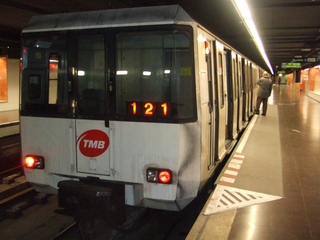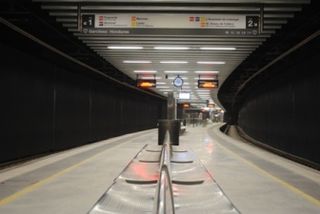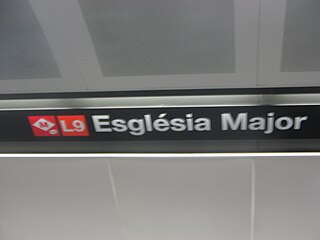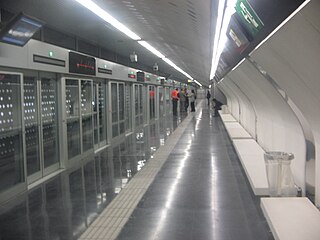
The Barcelona Metro is a network of rapid transit electrified railway lines that run mostly underground in central Barcelona and into the city's suburbs. It is part of the larger public transport system of Barcelona, the capital of Catalonia, Spain, with unified fares under the Autoritat del Transport Metropolità (ATM) scheme. As of 2014, the network is operated by two separate companies: Transports Metropolitans de Barcelona (TMB) and Ferrocarrils de la Generalitat de Catalunya (FGC). It is made up of 12 lines, combining the lines owned by the two companies. Two lines, L9 and L10, are being built at present, with both lines having different sections of each opened between 2009 and 2018. They are due to be fully completed in 2026. Three lines on the network have opened as automatic train operation/driverless vehicle systems since 2009: Line 11 being converted to driverless first, and then Lines 9 and 10, opening up driverless.

Trambesòs is a tram–light rail system in the Spanish autonomous community of Catalonia that links the Barcelona district of Sant Martí with Badalona and Sant Adrià de Besòs. Its name comes from the union of the words "tram", an abbreviation of the Catalan word for "tram" (tramvia), and "Besòs", the name of an area in the north of the Barcelonès region dominated by the Besòs River.

Line 1, shortened to L1, coloured red and often simply called Línia vermella, is the second oldest Barcelona Metro line, after line L3. It is the longest line of the Barcelona Metro, and links L'Hospitalet de Llobregat and Santa Coloma de Gramenet. Originally operated by the independent Ferrocarril Metropolitano Transversal de Barcelona, it is today operated by Transports Metropolitans de Barcelona (TMB) and is part of the ATM fare-integrated main transport system. L1 is the only metro line in Spain to use Iberian gauge tracks, as used by most Spanish main line railways.

Line 9 is a completely automated line of the Barcelona Metro network that is currently under construction, with 24 stations open in Barcelona and El Prat de Llobregat, L'Hospitalet de Llobregat, Badalona and Santa Coloma de Gramenet suburbs, since December 2009. The line is currently disconnected in two branches, with a connecting part between the two yet to be built. The Aeroport T1 – Zona Universitària section is called L9 South, and the La Sagrera – Can Zam portion L9 North. Upon completion, it will be the longest underground metro line in Europe.

Hospital de Bellvitge, formerly known as Feixa Llarga, is a Barcelona Metro station, in the L'Hospitalet de Llobregat municipality of the Barcelona metropolitan area, and named after the nearby Bellvitge University Hospital. The station is the western terminus of line L1.

Fondo is a Barcelona Metro station in the municipality of Santa Coloma de Gramenet, in the northern part of the metropolitan area of Barcelona. It is served by two metro lines, L1, of which it is the northern terminus, and L9. It was built in 1992 under Camí Fondo de Badalona, in the neighbourhood of Fondo, between Carrer Dalmau and Carrer Verdi.

Zona Universitària is a station in the Barcelona Metro and Trambaix networks, in the Les Corts district of Barcelona. It is currently the western terminus of metro line L3 and L9. Also it's served by tram lines T1, T2 and T3. It is named after the Universitat de Barcelona campus of the same name.

La Sagrera-Meridiana, simply known as La Sagrera, is an interchange complex underneath Avinguda Meridiana, in the Barcelona district of Sant Andreu, in Catalonia, Spain. It consists of a Rodalies de Catalunya station and three Barcelona Metro stations. The Rodalies de Catalunya station is located in the Meridiana Tunnel on the Lleida to Barcelona via Manresa railway, between Sant Andreu Arenal and Arc de Triomf, and is operated by Renfe Operadora. It is served by Barcelona commuter rail service lines R3 and R4, as well as regional rail line R12. The Barcelona Metro stations are on lines 1 (L1) and 5 (L5), as well as the northern section of line 9/10, and are operated by Transports Metropolitans de Barcelona (TMB). On the L1, the station is between Navas and Fabra i Puig, on the L5 between Camp de l'Arpa and Congrés, and on the L9/L10 between Plaça Maragall (future) and Sagrera - TAV. The station is also projected to become the terminus of the L4 once the extension from La Pau opens. A number of interurban bus services stop near the station.

Gorg is a Barcelona Metro and Trambesòs complex named after the neighbourhood of the same name where the station is situated, in Badalona municipality. It is located on Avinguda del Marquès de Mont-Roig and very close to Palau Municipal d'Esports de Badalona, the home arena of the professional basketball club Joventut de Badalona. It is served by TMB-operated Barcelona Metro lines L2 and L10, and Trambesòs route T5.

Torrassa is a Barcelona Metro station, in the L'Hospitalet de Llobregat municipality of the Barcelona metropolitan area, and named after the nearby La Torrassa neighbourhood. The station is served by line L1, line L9 and line L10.

Església Major is a Barcelona Metro station in the municipality of Santa Coloma de Gramenet, in the northern part of the metropolitan area of Barcelona underneath Plaça dels Enamorats. The station is named after the town's main church, located in Plaça de l'Església. It's served by L9 and is one of the stations comprising the first part of Line 9 to be opened, between Can Zam and Can Peixauet, inaugurated on 13 December 2009. Sanchez-Piulachs, Arquitectes S.L were in charge of the design of Església Major.

Singuerlín is the name of a Barcelona Metro station in the municipality of Santa Coloma de Gramenet, in the neighbourhood of Singuerlín, located in the northern part of the metropolitan area of Barcelona. It's served by L9, the first part of Line 9 to be opened, between Can Zam and Can Peixauet.

Can Zam is a Barcelona Metro station in the municipality of Santa Coloma de Gramenet, in the northern part of the metropolitan area of Barcelona. The station is located at the intersection of Avinguda Francesc Macià and Carrer Balmes. It's served by L9, the first part of line 9 to be opened, between Can Zam and Can Peixauet, both in Santa Coloma. Its inauguration took place on 13 December 2009.

Bon Pastor is a Barcelona Metro station named after the neighbourhood of the same name where the station is situated, part of Barcelona's district of Sant Andreu. This neighbourhood, one of Barcelona's most deprived areas and until very recently made up mostly of cheap public housing has been undergoing some renovation. The station was opened on 18 April 2010 with the opening of the line from this station to Gorg and Can Peixauet, enabling this neighbourhood to be connected with the metro network. It is served by TMB-operated Barcelona Metro lines L9 and L10.

Onze de Setembre is a Barcelona Metro station named after Rambla Onze de Setembre, one of the main streets in the neighbourhood of Sant Andreu de Palomar where it is located, part of Barcelona's district of Sant Andreu. It was opened with the opening of the L9/L10 section between Bon Pastor and La Sagrera stations on 26 June 2010. It is served by TMB-operated Barcelona Metro lines L9 and L10.

La Salut is a Barcelona Metro station named after the neighbourhood of the same name where the station is situated, in Badalona municipality. It was opened on 18 April 2010 with the opening of the line from Gorg to Bon Pastor. It is served by TMB-operated Barcelona Metro line L10.

Santa Rosa is a Barcelona Metro station in Santa Coloma de Gramenet, a suburb of Barcelona. It's served by L9. The station opened in September 2011 in a previously built line section between Fondo and Can Peixauet. Its only entrance is in Avinguda dels Banús at the intersection with Carrer d'Irlanda. Its platforms are 108 metres long and located 44 m. under the street level. The area around the station underwent a refurbishment including a new square.

Llefià is a Barcelona Metro station named after the neighbourhood of the same name where the station is situated, near Llefià Market, in Badalona municipality. This neighbourhood is one of Badalona's with highest population density and built in a very uneven piece of land. The station was opened on 18 April 2010 with the opening of the line from Gorg to Bon Pastor. It is served by TMB-operated Barcelona Metro line L10.

Parc Logístic is a Barcelona Metro station, in the Zona Franca district of Barcelona. The station is served by line L9.






















